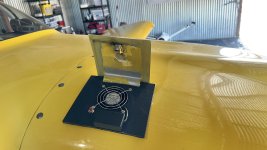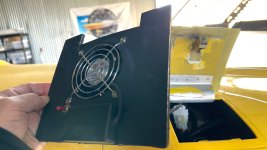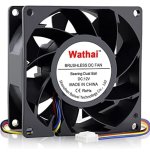


Do you by chance have the part number for the fan, or have an Amazon link that you can share? Sounds like a great idea!I flew to Father’s Day breakfast fly-in last Sunday and another fly-in today. Both days had Heat Dome temps near 90F in the Ohio Valley… I used cooling fan to suck heat out of cowling when parked. Engine is nicely cooled for return flight…
12VDC Standard Brushless Cooling Fan 120mm x 25mm Dual Ball Bearing 3.0 Watt 45 CFM (Amazon - $10). Fan draws 0.25A so it can run for long time with minimal battery drain. Fan plugs into battery charging pigtail, so no installation to speak of.Do you by chance have the part number for the fan, or have an Amazon link that you can share? Sounds like a great idea!
If you’re looking for the rechargeable one I use, search Amazon for “Aluan desk fan”.Do you by chance have the part number for the fan, or have an Amazon link that you can share? Sounds like a great idea!
On the premise that more is better, I opted for this 80 CFM 12v fan. the fan is smaller (80 cm) as I wanted it to mount in a frame so it wouldnt fall in through the oil door opening. It is louder, and does tend to draw onlookers when the plane is parked at a fly-in or something.12VDC Standard Brushless Cooling Fan 120mm x 25mm Dual Ball Bearing 3.0 Watt 45 CFM (Amazon - $10). Fan draws 0.25A so it can run for long time with minimal battery drain. Fan plugs into battery charging pigtail, so no installation to speak of.

For $20, an hour of my time, and no other downside, I didn't see it as worth the data acquisition effort. I will say that my empiric observation over last summer and so far this summer, including nine 20-minute Young Eagles flights a couple of weeks ago, is that the device accomplishes what I expected from it.What’s the temp delta between passive cooling with the door open and fan cooling? Somebody please take an IR thermometer shot in one hour and let us know the difference.
It sounds like a good idea but without the data to back up the theory………..
If you put a 70 cfm fan on your oil door after landing and put your hand 6” in front of the fan you won’t be able to keep it there. Compared to an open door the heat escaping with the fan is significantly higher.What’s the temp delta between passive cooling with the door open and fan cooling? Somebody please take an IR thermometer shot in one hour and let us know the difference.
It sounds like a good idea but without the data to back up the theory………..
Exactly my experience. Plenum aside, evacuating heat from the engine compartment can't be a bad thing, I'm thinking.If you put a 70 cfm fan on your oil door after landing and put your hand 6” in front of the fan you won’t be able to keep it there. Compared to an open door the heat escaping with the fan is significantly higher.
Exactly my experience. Plenum aside, evacuating heat from the engine compartment can't be a bad thing, I'm thinking.
I don't. When I park, I just open the oil door, plug the thing into the battery charging connector, turn it on and walk away.For those of you who do this (and it sounds like a good idea or at least one where there's no downside), do you block the air inlets so you're drawing air up through the cylinder fins? Otherwise, you may be pulling air in through the inlets and (mostly) above the cylinders, as opposed to through them.
For the 360 engines the oil door is behind the baffle seal area. I guess it's the same on the Rotax.For those of you who do this (and it sounds like a good idea or at least one where there's no downside), do you block the air inlets so you're drawing air up through the cylinder fins? Otherwise, you may be pulling air in through the inlets and (mostly) above the cylinders, as opposed to through them.
Just ordered one...worth a try!I like my USB rechargeable fan. Adjustable speed too. Got it on Amazon.
Good idea, too!Solar powered vent fans are widely used on sailboats and the like, designed to fit into a 3 - 4" dia hole
View attachment 65417.
Great idea, but for my part I'm just trying to mitigate high temps under the cowl that might affect fuel vaporization in the lines, which in turn might lead to hard short-turn-around restarts. I've found no value in active venting for more than an hour even on hot days. A MOLEX connector on the batteries is pretty simple, so....plug and play for me.Solar powered vent fans are widely used on sailboats and the like, designed to fit into a 3 - 4" dia hole
View attachment 65417.
The Peltier draws 60 watts compared to my 120mm fan at 4.5 watts, it’s not a very efficient use of power. The trick is to get airflow through the cowl pulling the heat out with it, the fan does that well. Parking nose or tail into the wind also works but isn’t always possible.I wonder if a Peltier powered fan could work well for this.
Perhaps something like this:
It might be better to have more of a stand-off between the fan and hot-side; to allow more flow and direct the flow away from the surface of the cowl.
Used like this, with a very hot pool to draw from, the Peltier will generate power.The Peltier draws 60 watts compared to my 120mm fan at 4.5 watts, it’s not a very efficient use of power. The trick is to get airflow through the cowl pulling the heat out with it, the fan does that well. Parking nose or tail into the wind also works but isn’t always possible.